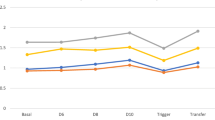Abstract
Purpose: To determine the haemodynamic parameters in women with tubal and male factors of infertility and to investigate the effect of ovarian stimulation on the blood flow indices of the uterine and ovarian arteries.
Methods: Prospective evaluation of the pulsitility index (PI) and resistance index (RI) of the uterine and ovarian arteries in the tubal and male factors of infertility was done. Comparisons were made between the natural and ovarian stimulation cycles.
Results: In natural cycles, uterine PI was 3.55 ± 1.39 and RI was 0.95 ± 0.05 in tubal infertility. These were significantly lower (uterine PI = 4.13 ± 0.08; uterine RI = 0.99 ± 0.06) than the corresponding indices in patients with male factor infertility. After ovarian stimulation in tubal factor, uterine PI and RI were 2.62 ± 0.73 and 0.88 ± 0.08 and were similar (PI = 2.55 ± 0.62, RI = 0.87 ± 0.06) to male factor infertility.
Conclusions: The data points to measurable differences in the uterine PI and RI between the tubal infertility and male infertility in the natural cycles. These differences were abolished after ovarian stimulation.
Similar content being viewed by others
REFERENCES
Goswamy RK, Steptoe PC: Doppler ultrasound studies of the uterine artery in spontaneous ovarian cycles. Hum Reprod 1988;3:721-726
Bassil S, Magritte JP, Roth J, Nisolle M, Donnez J, Gordts S: Uterine vascularity during stimulation and its correlation with implantation in in vitro fertilization. Hum Reprod 1995;10:1497-1501
Tekay A, Martikainen H, Jouppila P: Comparison of uterine blood flow characteristics between spontaneous and stimulated cycles before embryo transfer. Hum Reprod 1996;11:364-368
Coulam CB, Bustillo M, Soenksen DM, Britten S: Ultrasonographic predictors of implantation after assisted reproduction. Fertil Steril 1994;62:1004-1010
Zaidi J, Jurkovic D, Campbell S, Okokon E, Tan SL: Circadian variation in uterine artery blood flow indices during the follicular phase of the menstrual cycle. Ultrasound Obstet Gynecol 1995;5:406-410
Zaidi J, Jurkovic D, Campbell S, Pittrof R, McGregor A, Tan SL: Description of circadian rhythm in uterine artery bloodflow during the peri-ovulatory period. Hum Reprod 1995;10:1642-1646
Favre R, Bettahar K, Granger G: Predictive value of transvaginal uterine Doppler assessment in an in vitro fertilization program. Ultrasound Obstet Gynecol 1993;3:350-353
Yeung SB, Lau YL, So WK, Ng HY, Chan TH, Ho PC: Assisted reproduction technology in Queen Mary Hospital: Ten years' experience. Chin Med J Engl 1997;110:444-447
Steer CV, Campbell S, Tan SL, Crayford T, Mill C, Mason BA, Collins WP: The use of transvaginal color flow imaging after in vitro fertilization to identify optimum uterine conditions before embryo transfer. Fertil Steril 1992;57:372-376
Cacciatore B, Simberg N, Fusaro P, Tiitinen A: Transvaginal Doppler study of uterine artery blood flow in in vitro fertilization-embryo transfer cycles. Fertil Steril 1996;66:130-134
Steer CV, Tan SL, Mason BA, Campbell S: Midlutealphase vaginal color Doppler assessment of uterine artery impedance in a subfertile population. Fertil Steril 1994;61:53-58
Verco CJ, Carati CJ, Gannon BJ: Humanendometrial perfusion after tubal occlusion. Hum Reprod 1998;13:445-449
Verco CJ: Mammalian oviduct vasculature and blood flow. Archiv Biol Med Exp 1991;24:229-239
Verco CJ: Fallopian tube anatomy, microanatomy, microcirculation and counter current exchange. In The Fallopian Tube. Clinical & Surgical Aspects in JG Grudzinskas, MG Chapman, T Chard, O Djahanbakhch (eds), London, Springer-Verlag, 1993, pp 3-15
Diamond E: Microsurgical reconstruction of the uterin tube in sterilized patients. Fertil Steril 1977;28:1203-1210
Eddy CA, Pauerstein CJ: Anatomy and physiology of the fallopian tube. Clin Obstet Gynecol 1980;23:1177-1193
Author information
Authors and Affiliations
Rights and permissions
About this article
Cite this article
Basir, G.S., Lam, T.P.W., O, WS. et al. CLINICAL ASSISTED REPRODUCTION: Haemodynamic Evaluation of Tubal and Male Factors of Infertility in Natural and Ovarian Stimulation Cycles. J Assist Reprod Genet 18, 125–128 (2001). https://doi.org/10.1023/A:1009489518468
Issue Date:
DOI: https://doi.org/10.1023/A:1009489518468




